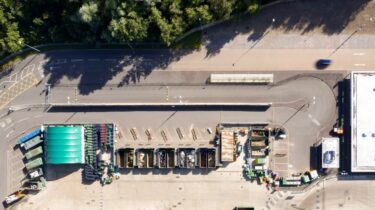
The UK government has introduced an extended producer responsibility (EPR) regulation for packaging. This means that the way UK organisations responsible for packaging must carry out their recycling responsibilities is changing.
If you are affected by the EPR for packaging, you will need to report your packaging data from 1 January 2023.
UK EPR for Packaging: What You Need to Do Now
The UK government has introduced an extended producer responsibility (EPR) regulation for packaging. This means that the way UK organisations responsible for packaging must carry out their recycling responsibilities is changing.
If you are affected by the EPR for packaging, you will need to report your packaging data from 1 January 2023.
Share this guide
Contents
- Who it impacts
- Key dates
- What it means for organisations
- Packaging Waste Recovery Notes
- Priority steps
- Our Support
Share this article
Who does it impact?
The regulation will apply to all UK organisations that handle and supply packaging to consumers and to businesses.
You will need to report packaging data if all the following apply:
- You are an individual business, subsidiary or group (but not a charity)
- You have an annual turnover of £1 million or more (based on your most recent annual accounts)
- You are responsible for over 25 tonnes of packaging in a calendar year (January to December)
- You carry out any of the packaging activities listed below
- Supply packaged goods to the UK market under your own brand
- Place goods into packaging that’s unbranded when it’s supplied
- Use ‘transit packaging’ to protect goods during transport so they can be sold to UK consumers
- Import products in packaging
- Own an online marketplace
- Hire or loan out reusable packaging
- Supply empty packaging
What are the key dates?
What you need to do depends on whether you’re classed as a ‘small’ or ‘large’ organisation here.
- If you are a large organisation, you will need to report data every six months. For the period January to June, report data between July and 1 October. For the period July to December, report data between 1 January and 1 April. Reporting of the 2023 data will follow these as a ‘soft target’ deadline, with a mandatory deadline extended to 31st May 2024 for businesses registered in England and Scotland. However this will revert to twice yearly deadlines for 2024 reporting onwards.
- If you are a small organisation, you will need to report your data between 1 January and 1 April.
- Registrations for the new ‘report packaging data’ (RPD) service opened in August 2023 and will remain open for any new producers to join for the foreseeable future.
- If you miss the mandatory deadline, you may need to pay a penalty charge.
What does it mean for organisations?
Under the new regulations, you may need to:
- Collect and report data on the packaging you handle and supply
- Pay a waste management fee
- Buy packaging waste recycling notes (PRNs) or packaging waste export recycling notes (PERNs) to meet your recycling obligations (most often bought via your Compliance Scheme)
- Report information about where your packaging has been sold, hired, loaned, gifted, or discarded – this is called ‘nation data’
Packaging Waste Recovery Notes to Packaging EPR
For a producer to report using the new 2023 requirements, there are some parallels which allow you to utilise existing reporting information sources, but also plenty of extra requirements that are new for 2023.
Previously weights, materials and handling activities were measured and monitored for just your own operations and knowing who your customer was. When looking back, this seems comparatively easy.
Handling obligations are now simplified, but importer and manufacturer status will still be relevant for most organisations’ activities and reporting.
- Product specific packaging weights (kg) and eight material data categories with various subcategories
- Distinction between single-use and reusable
- Levels of sales packaging, or Group and Transit packaging (primary, secondary, shipment or transit packaging)
- Household and household-like, or non-household destination
- Street bin waste
- A drinks container (not Scotland, and only on 50ml-3lts)
- Self-managed waste (where it came from and where it is sent for recycling by primary, secondary, shipment or transit packaging)
- Brand owner, or importer status of packaging into the UK
- New fibre based composite material category typically found in laminated grocery packaging
- Nations data for which nation is packaging supplied and where it will be discarded
3 priority steps to transition to the new Packaging EPR Regulation
- Budget: Organisations will need a new bigger budget ready to pay in 2025 based on their 2024 sales. The total costs for all organisations are expected to be around £1.7B/yr compared to the old PRN system which was around £200-£300M/yr. The new ‘Waste management fee’ is to be paid to the national administrator body and is expected to be formed in 2023. This is in addition to the Plastic Tax, and the soon to be implemented Deposit Return systems in Scotland and the rest of the UK.
- Product data: Revisit what data you have given the impact of the new regulations, tightening up on accuracy, reducing over-reporting, and gathering new data parameters will be necessary for the first new EPR submission from July 2023. Ongoing management of data is becoming increasingly valuable for compliance and commercial needs.
- Packaging strategy: Any business with household or household-like packaging is likely to be worse off under the new packaging EPR system. More time, cost, and tasks will be necessary. Improving on unique business scenarios, the ability to recover costs ahead of time, benefits of adapting supplier and customer contracts all can be mitigated in the longer run. Rolling up these into a wider packaging goal will amplify the value released across the business beyond just EPR fees.
There are four systems which may look the same but are actually different requirements depending on where you sell:
- Large Producer EPR
- Small producer EPR
- Plastic Packaging Tax
- Scottish Deposit Return Systems (DRS)
Other reporting parameters that need to be considered:
- Outgoing PRN system
- EPR seller (nations reporting)
- …and future rest of UK DRS systems (to be confirmed)
How can Anthesis support you?
Many businesses are still confused or unaware of the upcoming changes. The relative simplicity, and until the last few years, low annual fees of the old PRN system often led to complacency. Now, packaging and supply chain data is more important than ever, and includes activities and contractual arrangements beyond that of your own immediate sales terms.
Improved transparency of packaging and business activities needs to be paired with technical interpretations of the new regulations. Anthesis has a team of packaging specialists and EPR experts with nearly two decades of operational experience to support clients navigate the EPR reform. There are many new definitions introduced under EPR reform, and each needs assessment for the potential impacts. A great example is the responsibilities around branded and unbranded packaging. Depending on who is responsible, you may not need to report on everything.
Anthesis has been supporting many large businesses with their packaging portfolios as part of EPR reform and strategic packaging goals. This has improved the transparency of supply chains and the accuracy of product packaging information. Familiarity with the latest guidance and product supply chains makes us ideally positioned to support clients get ahead of the requirements, to help gather information rapidly, and to model the possible financial impacts of the upcoming EPR fees.
A greater understanding of the upstream and downstream supply chain is necessary because in many instances it will impact who is responsible to report and pay for the packaging they are handling. Also, policy overlaps of EPR regulations has created a huge complexity concerning who and what is paid. Understanding where and when your organisation is responsible will avoid any enforcement action.



